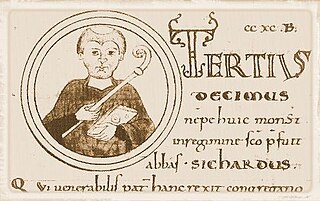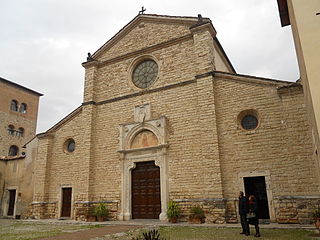
Farfa Abbey is a territorial abbey in northern Lazio, Central Italy. In the Middle Ages, it was one of the richest and most famous abbeys in Italy. It belongs to the Benedictine Order and is located about 60 km (37 mi) from Rome, in the commune of Fara Sabina, of which it is also a hamlet.
Teuto was the Abbot of Farfa from about 883 until about 888. His abbacy is the first of a very unclear string that covers the years down to 919 at Farfa. He is known to have succeeded Anselm and been succeeded by Nordepert, but little else is certain. The period of his abbacy had already become obscure when Gregory of Catino was chronicling the abbey's history and editing its charters in the late eleventh century.

Sichard was a 9th century Italian monk. He was the Abbot of Farfa from c.830 to 842. His abbacy corresponds with a drop in the number of property transactions involving Farfa, perhaps because "[its] wealth was by that time sufficient to cover major building at the abbey itself." Sichard added an oratory to the existing abbey.
Guicpert or Wigbert was the abbot of Farfa for eleven months in 769–770 and probably also the Bishop of Rieti in 778. According to the twelfth-century chronicler of the abbey, Gregory of Catino, Wigbert was an Englishman and already a bishop when he convinced the dying Abbot Alan of Farfa to name him as his successor. From a twelfth-century perspective, Wigbert's accession was invalid because it was not in accordance with the Rule of Saint Benedict, although that rule was neither strictly nor uniformly enforced at Farfa in the eighth century. Nevertheless, the monks found Wigbert's rule a "tyranny" and sought the king, Desiderius, to remove him and confirm their freedom to elect a successor, which he did.
Wandelbert was the Abbot of Farfa sometime between 757 and 761, one of a series of abbots from Aquitaine. His abbacy coincided with a troubled period in the abbey's history and the stormy reign of Duke Gisulf of Spoleto, who seems to have brought some stability to the abbey by the time of his death.

Thomas of Maurienne was the first abbot of the Abbey of Farfa, which he founded between 680 and c.700. Although the sources of his life are much later, and he is surrounded by legends, his historicity is beyond doubt.
Ragambald was the Abbot of Farfa from 781 until his death. According to the abbey's twelfth-century historian Gregory of Catino, Ragambald was born in a city in Gaul (Gallia), that is, Francia, but he does not explicitly call him a Frank. Succeeding Probatus, a local-born abbot, Ragambald was the first of a line of abbots from Francia, including Altpert (786–90) and Mauroald (790–802). The significance of the Frankish presence at Farfa and of Ragambald's abbacy is summed up:
.. . the ‘new’ abbeys of the time not only arose under Frankish influence but also infiltrated the religious life of Lombard Italy with ‘Frankish’ ideas and attitudes, providing a kind of ‘fifth column’ that prepared the way for Frankish military victory and a more ready acceptance of Frankish political domination.
Anselm (Zelmo) was the Abbot of Farfa between 881 and 883, succeeding John I. His short abbacy is reasonably well-sourced compared to the string of five abbots following him, beginning with Teuto, who were extremely obscure figures even to Gregory of Catino, the abbey's historian of the eleventh century.
Vitalis was the "surrogate" Abbot of Farfa in 888, between the death of Spento and the election of the long-serving Peter. The history of the period in Farfa's history, besides the barest chronological outline, has been obscure since it was first written down, by Gregory of Catino in the late eleventh century.
Mauroald was a Frankish monk from Worms and the Abbot of Farfa from 790. Farfa, at less than a century old, was still interested in accruing territories through grants and donations in order to support its building projects and the expansion of its site.

Peter was the long-serving Abbot of Farfa from about 890 until his death. He replaced the interim abbot Vitalis. His abbacy marked the return of stability after a period which saw four abbots in the space of two years.
Benedict was the Abbot of Farfa, Italy from 802 until his death. He is the first abbot mentioned in the eleventh-century history of the abbey written by Gregory of Catino whose origins were not known.
Hilderic was the fifteenth Abbot of Farfa from 844. In 842 Abbot Sichard died, and the Emperor Lothair I (840–55) intervened to appoint Bishop Peter II of Spoleto in control of the abbey in the interim. Peter organised an election, in which the monks chose Hilderic, and convinced Lothair to confirm him in the abbacy in 844. From his death in 857 the history of the abbey falls into relative obscurity until about 920. The anonymous Libellus constructionis Farfensis, which in its original form was composed in the late ninth century, relates the history of Farfa from its foundation by Thomas of Maurienne down to the death of Hilderic.
Altpert was the Abbot of Farfa from the death of Ragambald in 786 until his own death a few years later. He was described by Gregory of Catino, writing some three centuries later, as having been born in Paris "of the Gauls" (Galliarum), presumably meaning that he was a Romance-speaking subject of the Carolingians. He increased the patronage of the abbey compared to his predecessor, but Farfa was still less successful in seeking out grants and donations than it had been under the local abbot Probatus. Altpert received a donation of lands at Rabenno from Duke Hildeprand of Spoleto, two other donations and one oblation.

Fulcoald (died 757x9) was the fourth Abbot of Farfa from 740. In 739 King Liutprand granted Farfa the right of freedom in abbatial elections, but we do not know if Fulcoald was the product of such a free election or not. Like his predecessor, Lucerius, Fulcoald hailed from Aquitaine, then in southern Francia. "With his abbacy, the quantity of our [historical] evidence dramatically increases [and d]evelopments in secular politics can now be seen to impinge on Farfa's land acquisitions." Fulcoald's abbacy can therefore be defined in terms of three objectives that are apparent in the surviving sources: (a) to extend its landholdings and secure its rights to its properties, (b) to promote a strict and disciplined monastic observance, and (c) to "steer as untroubled a course as possible through the choppy waters of Italian politics".

Alan was an Aquitanian scholar, hermit and homilist who served as the sixth Abbot of Farfa in central Italy from 761. Before taking over at Farfa, Alan composed the Homiliarium Alani, "one of the most successful homiliaries of the late eighth and early ninth centuries", traces of which may be found in the liturgical formulae scattered throughout Farfa's eighth-century charters.
Nordepert was briefly the Abbot of Farfa in 888. He succeeded Teuto and was succeeded by Spento, but the exact dates of these abbacies were unknown as early as the eleventh century, when Gregory of Catino compiled the abbey's history. Nordepert appears to have been elected in the same year as he died.
Hugh was the Abbot of Farfa from 998. He founded the abbatial school and wrote its history from the late ninth through the early eleventh century under the title Destructio monasterii Farfensis. A later student of his school, Gregory of Catino, wrote a fuller history of the monastery partly based on Hugh's earlier account.
Probatus was the Abbot of Farfa from 770 until 781, and the first abbot native to the Sabina. He steered the abbey through the fall of the Kingdom of the Lombards, trying to prevent the disastrous aggression of its last king, and kept it from falling under the jurisdiction of either the Papacy or the Papal States. With the benefit of his local connections he oversaw a great expansion of the abbey's properties through grants and purchases, and also rationalised its holdings to create a robust base for an early medieval monastic community.

Gregory of Catino was a monk of the Abbey of Farfa and "one of the most accomplished monastic historians of his age." Gregory died shortly after 1130, possibly in 1133.